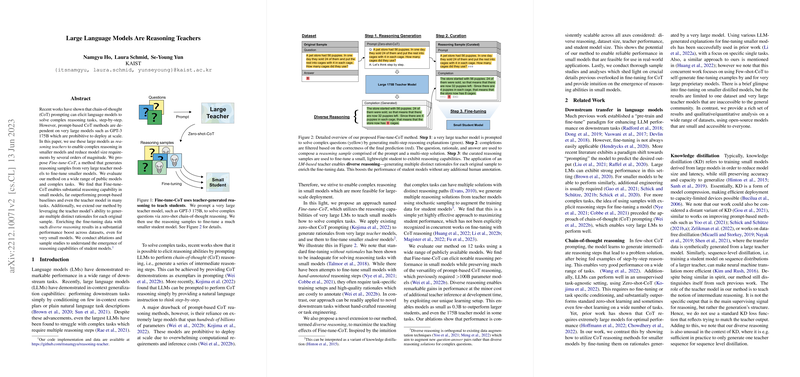Insights from "LLMs Are Reasoning Teachers"
The paper "LLMs Are Reasoning Teachers" proposes an approach to distill complex reasoning capabilities from very LLMs to significantly smaller models using a method termed Fine-tune-CoT. This method leverages the reasoning abilities of large teacher models, such as GPT-3 175B, to enhance the reasoning capabilities of small student models through fine-tuning on generated reasoning samples. This not only addresses the computational and economic infeasibility of deploying large models at scale but also significantly reduces the required model size while maintaining or even improving performance on complex reasoning tasks.
Methodology and Key Findings
The core of this approach lies in the Chain-of-Thought (CoT) reasoning capability, where LLMs generate step-by-step rationales to arrive at solutions for complex tasks. The Fine-tune-CoT method utilizes these CoT capabilities by having large models generate reasoning examples and then using these examples to fine-tune smaller models (students). The authors provided extensive experimentation, demonstrating that student models fine-tuned with this approach outperform prompt-based baseline methods significantly across a wide variety of reasoning tasks. Intriguingly, in many cases, the student model not only surpassed the performance of prompt-based methods but also sometimes exceeded the correctness of the teacher model itself, especially when leveraging diverse reasoning paths.
The method was tested on 12 datasets, categorized under arithmetic, symbolic, commonsense, and other reasoning types, showcasing substantial improvements in performance of student models across the board, achieving state-like performances in certain reasoning categories.
Practical Implications and Speculation on Future Developments
The implications of this work in both practical and theoretical realms are manifold. On the practical side, the ability to scale down yet effectively deploy complex reasoning capabilities democratizes access to logical reasoning in machine learning, making it feasible on more modest computational resources, thus broadening the usability of AI in resource-constrained environments. For industrial deployments in real-world applications, this approach provides a cost-effective means to leverage advanced reasoning without the exponential costs associated with LLMs like GPT-3.
Theoretically, this work nudges the research community towards a deeper understanding of reasoning emergence in neural networks and lays groundwork for future methodologies in model distillation and efficiency boundaries. This approach also posits an intriguing question about how reasoning capabilities can be generalized and transferred across dissimilar model architectures, providing ample room for exploration in various neural architectures.
Discussion on Fine-tuning Performance and Scalability
The paper highlights the scalability of Fine-tune-CoT along several dimensions — additional data, student model size, and diverse reasoning examples. This scalability is crucial for performance improvement, showing that Fine-tune-CoT can adapt to improve reasoning performance further with the augmentation of these factors. The discussion section thoroughly addresses the trade-offs and choices alluding to promising avenues for incorporating better student teaching models and optimization of rationales extracted from teachers.
Conclusion and Future Directions
In conclusion, this paper successfully demonstrates a pioneering way to bridge the gap between large-scale machine reasoning and practical deployability. While not laying claim to dramatic theoretical breakthroughs, it provides a valuable method that aligns with the pursuit of efficiency without forfeiting reasoning proficiency. For future exploration, it opens avenues for enhancing diverse reasoning, leveraging more sophisticated CoT methods, and exploring connections with knowledge distillation. The community may witness proposals that expand upon these findings to further amplify the reasoning competencies of small models, setting the stage for advancements in how AI systems infer, learn, and generalize knowledge.
